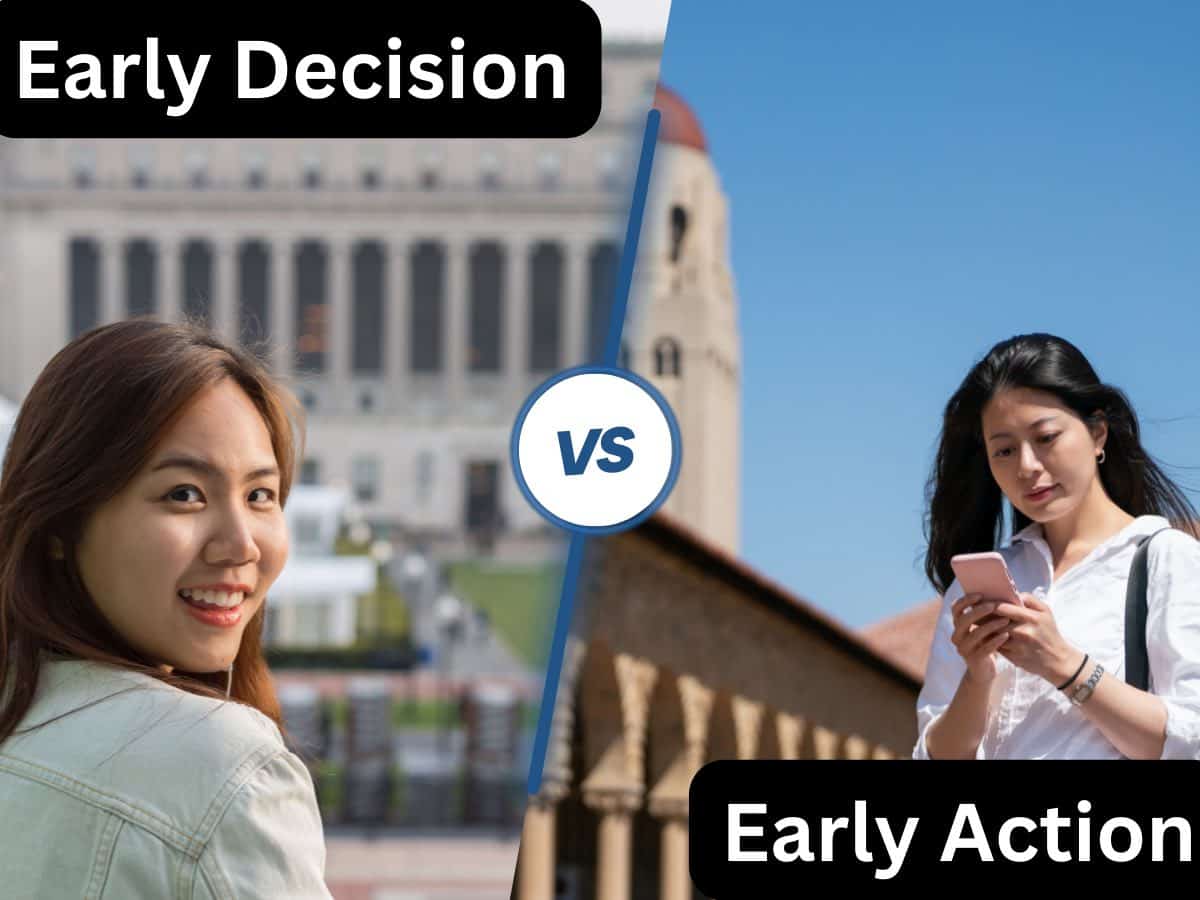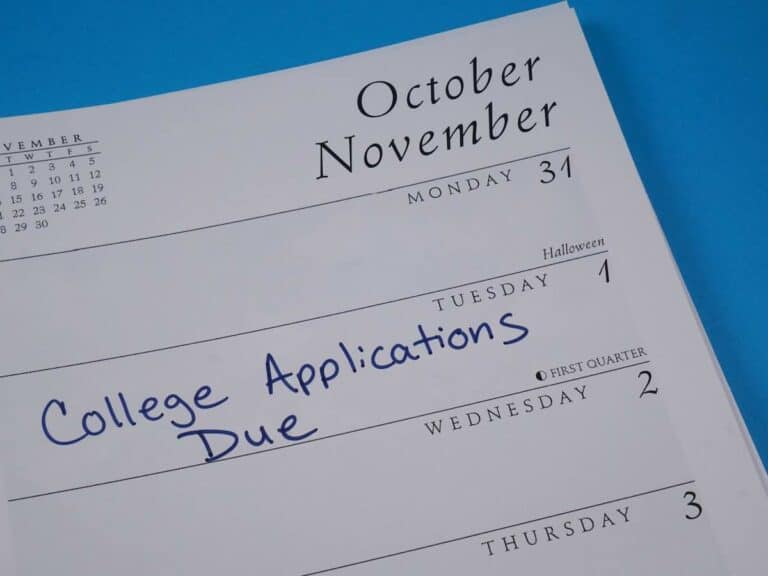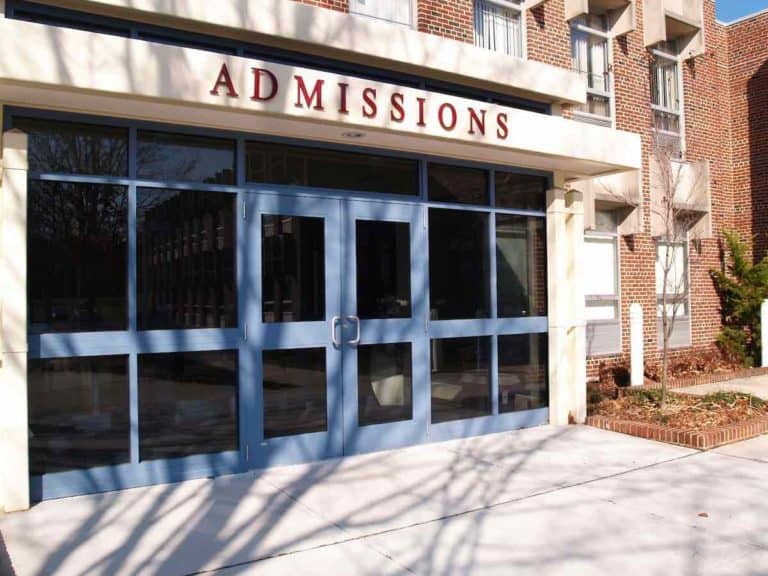Early Action Vs. Early Decision: Differences, Cons, and Pros
Early college admission plans, such as Early Decision (ED) and Early Action (EA), provide two main advantages over regular decisions:
- You know about admission decisions in January-February rather than in March-April.
- Your chances of getting admitted are higher in the early rounds.
Yet, Early Decision and Early Action plans differ in how they limit your college options.
Both Early Decision and Early Action admission plans have early application deadlines. Students can only apply to one ED college because the ED plan is binding, and students must attend the college if accepted. But students can apply to many Early Action colleges because the EA plan is not binding.
What is the Early Decision Plan?
Early decision is an admission plan that allows students to apply to their top-choice schools earlier than the rest. Any student who gets accepted via ED must attend the college because it’s a binding arrangement.
The vast majority of institutions of higher education that offer ED are selective schools looking for competitive applications and have low acceptance rates.
How Does Early Decision Work: Rules, Pros, and Cons
The earliest date college-bound high schoolers can apply to colleges is by means of an early decision plan.
Since it allows for an earlier review of applications, ED applicants hear back from schools earlier, too, which is ideal for those who wish to secure a spot at their dream colleges and focus on the rest of high school in the meantime.
However, it’s very important for them to note that, besides being a binding admission program, ED also prohibits students from submitting applications to other schools’ ED.
However, they may still apply through other admission plans such as early action and regular decisions. If accepted via ED, students must withdraw their applications to other colleges.
Some of the advantages of applying ED include:
- Increased admissions chances
- Less stressful senior year
- Access to better housing options
- Access to higher financial aid offers
On the other hand, the following are some of ED’s cons:
- The application has to be completed earlier
- Binding — students must attend if accepted
- Inability to compare financial aid offers
- Competition with other competitive applicants
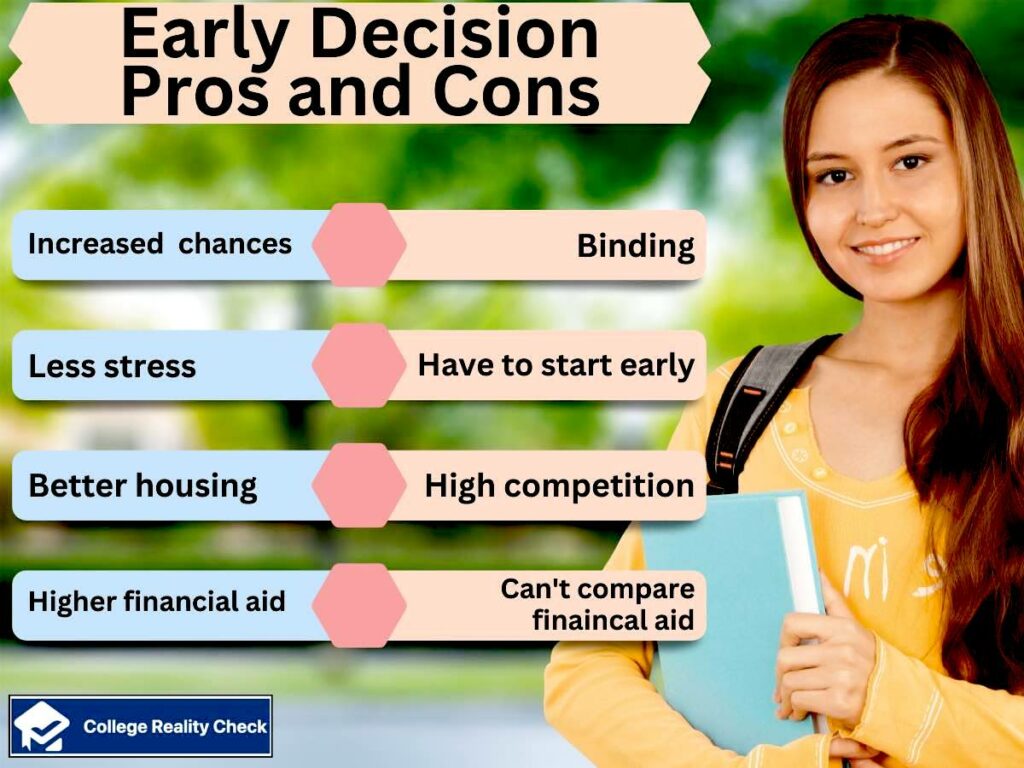
Early Decision Dates and Deadlines
It’s true that early decision has earlier deadlines and decision dates than regular decision. However, how early the ED-associated dates are can vary from different schools with the said early admission plan.
For instance, the ED application deadline at Dartmouth College is November 1 and admissions decisions come out by mid-December.
On the other hand, at Swarthmore College, the ED application deadline is November 15 and students who get accepted or rejected hear back from the institution in mid-December, too.
Financial aid application deadlines, meanwhile, are also usually the same as ED deadlines.
At Harvey Mudd College, for instance, early decision students who wish to apply for financial aid must hand in their completed FAFSA form and CSS Profiles by the same slated deadline as for ED applications.
Is Early Decision Binding?
Early Decision is a biding early admission plan. A student accepted by an ED school must matriculate. Early Decision schools ask for the signatures of the applicants, parents, and counselors as a form of verification of the commitment of applicants to attend if accepted.
Can you break early decision binding contract?
Early Decision is binding as far as the college admissions process goes, but it’s not a legal contract. In other words, colleges cannot sue ED students who back out, although they may choose to impose consequences.
Nothing will happen to the student who gets accepted to a college through the early decision and then backs out of the agreement if he or she has a valid reason for doing so, such as:
- Dealing with a family emergency or another critical matter
- Contracting a serious health concern
- Inability to pay tuition — the contribution is way below what the net price calculator has promised
On the other hand, there could be serious consequences if the ED student backs out without a good reason.
The early decision college, for instance, will share the name of the student with other postsecondary institutions — those schools could then choose to blacklist the individual for deceiving a fellow school.
Therefore, if you contemplate backing out of ED acceptance, please contact the school first and discuss your situation.
Can I apply Early Decision to multiple schools?
Because the Early Decision is binding, students can apply to only a single institution. Otherwise, multiple ED acceptance from different schools would mean backing out of the rest, which would go against the binding aspect of the ED plan. Similarly, it’s prohibited to apply ED 2 to various schools.
Can you apply regular decision after early decision?
Students may apply in the Regular Decision round to other schools once their early decision application was denied or deferred. However, there is no need for a student to apply RD to the same college after getting deferred via ED.
That’s because his or her application is automatically moved to the RD application pool for later review together with the rest of the RD applicants.
How Much Does Early Decision Increase Chances of Admission?
Usually, early decision increases an applicant’s chances of getting accepted by as much as 10%, says the State of College Admission by the National Association for College Admission Counseling (NACAC) — colleges report having higher acceptance rates (61%) for ED applicants compared with all other applicants.
It’s true that early decision have earlier deadlines, which means that students who are willing to commit to their first-choice schools have to act faster than everyone else to apply on or before the last day of ED applications.
However, in return is that ED acceptance rates are usually higher than regular decision acceptance rates.
So, does applying early decision help a student get into a selective college?
The answer is yes and no — given that the ED application pool often consists of strong applicants, it’s important for the student to meet or surpass the academic profiles of most students admitted to the school. Otherwise, applying ED alone may not gain him or her admission.
Generally speaking, still according to NACAC, ED acceptance rates are higher at colleges with lower yield rates.
Is ED Better Than Regular?
Applying early decision is better than applying regular decision only if the student can afford the cost of attendance at the college and if the institution is the top-choice school.
A top-choice school is an institution that meets the student’s academic and personal needs, which is why it’s usually placed at the top of his or her college list.
Just because college-bound students have their applications ready so much earlier than everybody else doesn’t mean they should apply ED — the early admission plan should be reserved for those who are confident with their college choice.
Meanwhile, it’s not for students who find it important to compare financial aid offers beforehand.
When Early Decision Results Come Out
Because early decision is an early admission program, naturally, decision notifications come out earlier, too, thus allowing rejected or deferred students to plan the next few steps sooner.
On the other hand, students who get accepted via ED have no other matter to worry about but to matriculate to college and then focus on the rest of their high school careers.
Early Decision and Financial Aid
While at times students who apply early decision receive financial aid award letters at the same time they receive admissions decision notifications, it’s not uncommon for some ED schools to release financial aid awards at a later date, such as in January.
No matter the financial aid award letter release dates, ED students cannot compare offers from various schools.
An ED admission plan provides a win/win situation for both parties concerned, the students and colleges — it increases the chances of students getting into their dream colleges and it boosts the yield rate of ED institutions.
Unfortunately, for students who are admitted via ED, comparing financial aid is not an option simply because it’s out of the question.
It’s important to keep in mind that applicants can apply to only a single ED college at a time, and those who get accepted are obligated to attend, no matter how generous or stingy the financial aid offer is.
Due to this, ED is not only for students with strong applications but also those who are willing to commit to the institution regardless of the total family contribution after aid.
The complex and confusing financial aid process can make it difficult for students to understand different college costs, know if they are being offered a grant or a loan, evaluate loan options, and figure out how much debt to take on. It’s important for students to understand the costs and risks of student loans before enrolling
(CFPB, 2022)
Contrary to popular belief, financial aid offers are not lower for ED applicants than for regular decision applicants.
Again, the only problem with applying ED aid-wise is that accepted students cannot compare offers from other schools. If it were true that ED students get lower financial aid packages, then all low-income students would back out.
Top 20 ED Schools
In most instances, early decision schools are some of the most competitive higher education institutions in the country, which means that they also have some of the lowest regular decision acceptance rates.
As such, applying ED to them is advantageous for students who have them as their top-choice schools, as the early admission plan helps increase admissions chances.
Here is a list of the top 20 early decision schools in the US according to the Best Colleges Offering Early Decision in America by Niche, together with their respective ED deadlines:
| University | ED Deadline |
|---|---|
| Rice University | 1-Nov |
| Duke University | 1-Nov |
| Brown University | 1-Nov |
| Dartmouth College | 1-Nov |
| University of Pennsylvania | 1-Nov |
| Columbia University | 1-Nov |
| Vanderbilt University | 1-Nov |
| Northwestern University | 1-Nov |
| Washington University in St. Louis | 1-Nov |
| University of Chicago | 1-Nov |
| Harvey Mudd College | 15-Nov |
| Pomona College | 15-Nov |
| Johns Hopkins University | 1-Nov |
| Carnegie Mellon University | 1-Nov |
| Cornell University | 1-Nov |
| University of Virginia | 1-Nov |
| Claremont McKenna College | 1-Nov |
| Bowdoin College | 15-Nov |
| Swarthmore College | 15-Nov |
| Barnard College | 1-Nov |
Early Decision I vs. II
Both early decision 1 and early decision 2 are binding early college admission plans. ED 1 has an earlier application deadline than ED 2, by 2 to 3 months. Students who were denied or missed the ED 1 deadline can apply in ED 2 to other selective colleges.
College-bound students who are decided to attend their top-choice schools will find it advantageous to apply earlier than everybody else, particularly via the early decision plan.
However, as expected, ED 2 acceptance rates are not as high as ED 1 acceptance rates, although it’s still usually higher than regular decision acceptance rates. Also, financial aid offers for ED 2 admits may not be as generous as financial aid offers for ED 1 applicants since it’s no secret that financial aid is offered on a first-come, first-served basis.
What Does Early Decision 2 Mean?
Similar to early decision 1, early decision 2 is an early admission plan — it allows students to apply earlier to their top-choice schools and hear back from them earlier, too. ED 2 is also single-choice, which means that students can apply to only a single ED 2 college, and may help increase their chances of getting admitted, too.

Is ED 2 Binding?
Early decision 2 is binding, just like ED 1. This means that students who are accepted through ED 2 must attend the college. Even though ED 2 has a later deadline as well as decision notifications than ED 1, it still requires students to sign a contract that establishes their commitment to matriculate and attend should they get accepted.
Besides their binding nature, ED 1 and ED 2 share another thing in common: they allow accepted students to back out if they have a good reason for choosing not to attend the early decision school.
In most instances, however, the inability to pay tuition is considered the only acceptable reason.
Early Decision 2 Schools
The following is a list of some of the most selective American institutions of higher education offering a second early decision option as well as their respective ED 2 deadlines:
| University | ED2 Deadline |
|---|---|
| American University | 15-Jan |
| Babson College | 2-Jan |
| Bates College | 10-Jan |
| Boston University | 4-Jan |
| Bowdoin College | 5-Jan |
| Brandeis College | 3-Jan |
| Bryn Mawr College | 1-Jan |
| Case Western University | 15-Jan |
| Claremont McKenna College | 10-Jan |
| Colgate University | 15-Jan |
| Connecticut College | 15-Jan |
| Davidson College | 8-Jan |
| Dickinson College | 15-Jan |
| Emory University | 1-Jan |
| Franklin & Marshall College | 15-Jan |
| George Washington University | 5-Jan |
| Grinnell College | 1-Jan |
| Hamilton College | 4-Jan |
| Harvey Mudd College | 5-Jan |
| Johns Hopkins University | 3-Jan |
| Kenyon College | 15-Jan |
| Lafayette College | 15-Jan |
| Middlebury College | 3-Jan |
| Mount Holyoke College | 4-Jan |
| New York University | 15-Jan |
| Northeastern University | 1-Jan |
| Occidental College | 10-Jan |
| Pitzer College | 6-Jan |
| Pomona College | 8-Jan |
| Rhodes College | 15-Jan |
| Scripps College | 5-Jan |
| Skidmore College | 15-Jan |
| St. Olaf College | 15-Jan |
| Swarthmore College | 4-Jan |
| Trinity University | 1-Feb |
| Tufts University | 4-Jan |
| Tulane University | 13-Jan |
| University of Chicago | 4-Jan |
| Vanderbilt University | 1-Jan |
| Vassar College | 1-Jan |
| Washington and Lee University | 1-Jan |
| Wellesley College | 1-Jan |
| Wesleyan University | 1-Jan |
| William and Mary | 2-Jan |
Students who fail to apply to their top-choice colleges ED 1 or receive an acceptance letter during the said early admission plan may apply ED 2 to increase their chances of getting in.
Here’s an article talking about the best ED 2 schools for those who were unsuccessful during the ED 1 round in detail.
What is the Early Action Plan?
Early action is an admission plan with an early deadline. The Early Action plan is non-binding, so students have time to decide whether to attend the EA college before May 1. But some plans, such as single choice or restriction early action, have additional college option limits.
Like early decision, EA is a strategy used by many schools to increase yield rate. True enough, according to NACAC:
“Thirty-eight percent of 4-year colleges offered early action plans, according to results of the 2018-19 Admission Trends Survey. Colleges with lower yield rates were more likely to offer Early Action. Forty-six percent of colleges with yield rates lower than 30 percent used early action” (Clinedinst, 2019).
How Does Early Action Work: Rules, Pros, and Cons
Early action is an admission plan that’s earlier than regular decision but later than early decision.
Naturally, because EA applicants submit their applications to their preferred colleges ahead of everybody except for ED applicants, they learn whether or not they are accepted earlier than usual.
Unlike ED, EA is non-binding, which means that those who get accepted via the said early admission plan are not required to attend.
Students can compare colleges furthermore and, especially, check out various financial aid offers before they make their final college choice. Students who apply in EA round may also apply via regular decision.
Pros of applying EA include the following:
- Non-binding
- Increased admissions chances
- Less stressful senior year
- Access to better housing options than RD students
- Access to higher financial aid offers than RD students
- Ability to compare various financial aid offers
EA’s downsides:
- Lesser admissions chances than ED students
- The application has to be completed sooner
- Competition with other competitive applicants
- Some forms of EA may restrict early application to other colleges
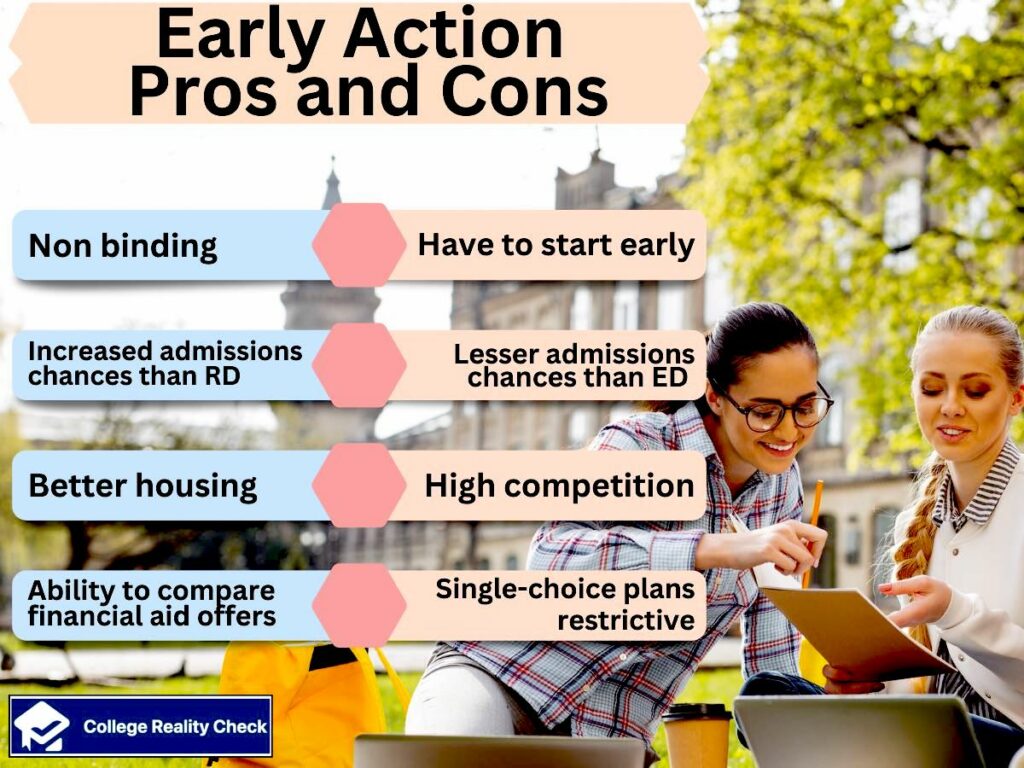
Early Action Dates and Deadlines
At most early action colleges and universities, the EA deadline is November 1.
However, institutions that offer students a second chance via an EA application have another deadline: November 15. Some EA schools have an earlier deadline such as October, while others with a later deadline usually require EA applicants to hand in their applications in December.
Other than the early action deadline itself, it’s also important for students to meet the deadline for financial aid applications. Since it’s usually at the same date as EA application, springing into action right away is a must.
Is Early Action Binding?
Early action (EA) is a non-binding admission plan. Students who get accepted via EA are not obligated to attend the college, which makes it possible for them to compare financial aid offers and pick the school with the most generous package. Due to its non-binding nature, EA is suitable for students with multiple top-choice schools.
It’s very much possible for college-bound teens to come across various colleges that equally meet their academic and personal preferences, which can make it difficult for them to make a choice especially as the application deadline nears.
EA is a non-binding early admission plan that allows them to apply to those until they are ready to choose the best.
How many early action schools can I apply to?
In most instances, students can apply early action to multiple schools — it may be an early admission plan similar to ED but it usually doesn’t restrict students from applying to only a single EA institution.
Because it doesn’t require accepted students to attend, EA eliminates the fear of the possible consequences of applying to many schools and refusing many offers.
Can you apply regular decision after early action?
Students who are denied admission during the early action round may choose to apply regular decision to other schools. There is no need to apply RD to the same school, however, if the EA application has resulted in a deferral. The deferred application is automatically moved to the RD application pool for another chance at getting in.
How Much Does Early Action Increase Chances of Admission?
Applying early action, according to data by NACAC, increases a student’s chances of getting admitted, on average, by up to 9%. As far as applying to a selective postsecondary institution with acceptance rates below 10%, the figure is a substantial increase.
Compared to early decision, however, admission rates for EA applicants are generally lower.
It’s for the fact that, unlike ED, EA is a non-binding early admission program.
Because students accepted via EA may or may not attend the college, admissions officers are not that confident that accepting more EA applicants can help boost yield rate.
Still, most EA applicants apply to their top-choice schools, which means they are more likely to attend than RD applicants.
Is Early Action More Competitive?
Compared to regular decision, early action is a more competitive admission plan — typically, students who apply EA have stronger applications than those who apply RD. However, compared to early decision, EA is not as competitive given that ED applicants demonstrate stronger commitment to attend and confidence in the strength of their applications.
Is Early Action Better Than Regular?
Applying in the Early Action (EA) round is better than Regular Decision (RD) for students who have all application materials ready before the deadline. Applying early increases one’s admissions chances compared to applying regularly to the same college. Additionally, universities often give more merit aid to early applicants.
When Early Action Results Come Out
Most early action colleges release admissions decisions in mid-December. However, it’s not uncommon for some to inform applicants about admissions results in January or February.
Either way, EA applicants hear back from postsecondary institutions much earlier than regular decision applicants, who are usually informed by colleges between mid-March and April.
Similar to early decision, students who apply EA find out the decisions of the colleges of their choosing sooner than everyone else, thus allowing them to be able to focus more on their remaining high school careers.
However, upon learning whether or not they are accepted, EA applicants need not make a choice right away.
Like everyone else who applies RD, those who are accepted by colleges by means of an early action admission plan have until May 1 to make up their minds.
Also known as National College Decision Day, the first day of the month of May is when accepted students have to put down an enrollment deposit to tell their colleges to hold their respective spots in the coming class.
So, in other words, they have almost a good 5 months to make up their minds, which they could since, as mentioned earlier, early action is a non-binding early admission plan, unlike early decision.
Financial Aid and Early Action
In some instances, early action applicants receive offers to enroll and financial aid offers at the same time. However, there are also times when they receive financial aid offers at a later date than their acceptance letters, usually anywhere from January to March.
Regardless, EA applicants can compare financial aid packages and choose a college based on offers.
Because EA does not oblige students accepted through the said early admission plan to attend, they can choose not to matriculate if they are not completely satisfied with the financial aid offer.
As mentioned earlier, a top reason for backing out of an ED arrangement is the inability to pay college costs.
Students accepted via EA need not worry about potentially suffering any consequences for not attending the college if their families cannot afford the school’s asking price minus financial aid — again, early action is non-binding.
Other than being displeased with the financial aid offer, EA students may refuse to attend the institution for any other reason.
It’s also common for students who get accepted via EA to have somewhat lower financial aid offers than those who gain admission via early decision, which is due to the fact that more generous offers usually go to those who get in first.
Best Early Action Schools
Many early action colleges and universities are some of the most competitive in the US.
As such, the vast majority of them have a stellar reputation and are highly ranked, too, by some of the most reputable college ranking sites. It goes without saying that most have very low acceptance rates, which are slightly increased by applying EA.
The following is a list of the top 20 early action schools in the land based on the Best Early Action Colleges in America by Niche together with their respective EA deadlines:
| University | EA Deadline |
| Massachusetts Institute of Technology | 1-Nov |
| Stanford University | 1-Nov |
| Harvard University | 1-Nov |
| Yale University | 1-Nov |
| Princeton University | 1-Nov |
| California Institute of Technology | 1-Nov |
| University of Chicago | 1-Nov |
| Georgetown University | 1-Nov |
| University of Notre Dame | 1-Nov |
| University of Michigan – Ann Arbor | 1-Nov |
| Georgia Institute of Technology | October 17 (in-state) and November 1 (out-of-state) |
| University of Virginia | 1-Nov |
| University of Southern California | 1-Nov |
| University of North Carolina at Chapel Hill | 15-Oct |
| Northeastern University | 1-Nov |
| University of Texas at Austin | 1-Nov |
| University of Georgia | 15-Oct |
| University of Wisconsin | 1-Nov |
| Babson College | 1-Nov |
| University of Miami | 1-Nov |
What is Restrictive (Single-Choice) Early Action?
Sometimes referred to as single-choice early action or restricted early action, restrictive early action is an early admission plan that is more limiting than early action but not binding like early decision.
Policies can vary at different REA colleges, which aren’t that many, but it’s certain that students applying REA cannot apply to another school via ED or REA, too.
How Does REA Work: Rules, Pros and Cons
In most instances, restrictive early action has the same deadline as early action: November 1.
REA is similar to EA in that they are both early admission programs and, more importantly, non-binding options. So, in other words, students who are accepted by means of REA are not obligated to matriculate at the college.
However, REA is, in a way, like early decision as it restricts students from applying to other colleges via the very same admission plan — college-bound teeners cannot apply REA to various schools.
Often REA applicants may apply to other institutions via EA and regular decision, although rules may vary across different REA colleges and universities.
Below are the pros of applying REA:
- Non-binding
- Increased admissions chances
- Less stressful senior year
- Access to better housing options than EA students
- Access to higher financial aid offers than EA students
- Ability to compare various financial aid offers
Now, here are REA’s cons:
- The application has to be completed sooner
- Applying to other schools via REA is not allowed
- Competition with other competitive applicants
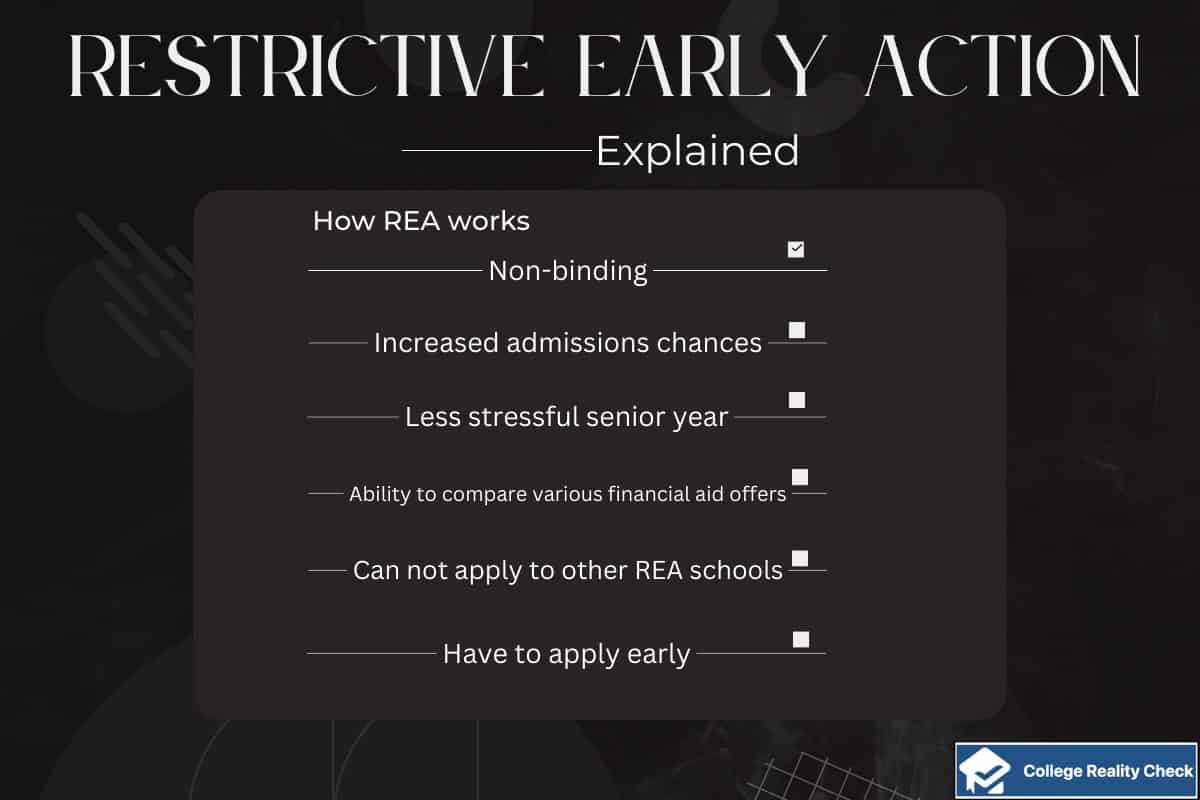
Is Restrictive Early Action Binding?
Restrictive Early Action (REA) is an early admission plan that allows students to apply to their top-choice schools and then hear back from them early, too. REA is a non-binding college admission plan. Students admitted via REA are not obligated to attend the college for financial aid or other reasons and/or others.
For some college-bound teens with numerous top-choice colleges, restrictive early action can be more attractive than ED because the said admission plan does not put them in an agreement where they should attend colleges that accept them.
However, others may find REA less attractive than early action.
This is especially true for students who have a lot of good schools on their minds that they would gladly attend should they receive an acceptance letter from each one of them.
Mainly, it’s because of the presence of the word “restrictive” in the early admission plan’s name, which is placed there by REA schools for a very important reason.
Can You Apply Restrictive Early Action to Multiple Schools?
Students cannot apply restrictive early action to multiple REA schools unless the college rules state otherwise. Similarly, they cannot apply REA to a school and then apply early decision to another.
However, it’s possible for students to apply to 1 REA college and apply EA or ED to other institutions during a single admissions cycle. The important thing to remember is they cannot apply REA and ED simultaneously.
For example, a student can apply to early to Yale, get denied and then apply to another ED2 school.
Restrictive Early Action vs. Early Decision
Restrictive early action, as the name suggests, is more restrictive than early action as it prohibits students from applying REA and even early decision to other colleges. However, it’s less restrictive than ED because it’s a non-binding early admission plan because students admitted via REA are not obligated to matriculate if given an offer to enroll.
Early Action vs. Restrictive Early Action
Both early action and restrictive early action are non-binding early admission plans. Students, however, may apply EA to several different schools at the same time as well as RD and early decision. On the other hand, they may apply to a single REA school only although they can apply to other schools via other admission plans with the exception of early decision.
Which Schools Have Restrictive Early Action?
Restrictive early action is a rare early admission plan because it’s offered only by a very small fraction of colleges and universities in the US, typically prestigious and selective ones. Some of them include Harvard, Princeton, Yale, Stanford, and Georgetown.
Harvard University Restrictive Early Action
The deadline for REA applications at Harvard is November 1 and decision notifications are released by mid-December. Students who apply to Harvard via REA may not apply ED, EA or REA, or any other binding plan to other institutions.
Princeton University Single-Choice Early Action
At Princeton, the deadline for single-choice EA is November 1. It’s important to note for applicants for the said plan that they may not apply via any early admission plan, whether restrictive or binding or not, to other colleges.
Yale University Single-Choice Early Action
November 1 is the deadline for Yale’s single-choice early action. Students who apply single-choice EA may also apply EA 1 or EA 2 to other schools as well as via any other non-binding admission plan, such as rolling admissions.
Stanford University Restrictive Early Action
Students who apply via restrictive early action to Stanford before the November 1 deadline may apply to other institutions, too, via regular decision but not by means of an early admission plan, binding or otherwise, such as ED, EA, or REA.
Georgetown University Restrictive Early Action
Like most other restrictive early action programs, students may apply to Georgetown via the early admission plan until November 1. They may also apply to other schools through the same plan as well as RD, except for binding plans.
What are the Differences Between EA and ED?
Knowing the key differences between early action and early decision is important for high schoolers preparing for their college careers so that they can have a much better idea of which early admission program is more suited for them when applying to their top-choice schools.
Also, it allows them to understand the restrictions that come with each.
In this part of the post, we will summarize the things that separate EA and ED from one another, thus making it clear that some students may benefit more from a particular plan, while some may benefit more from the other.

Binding Differences Between EA and ED
While early action and early decision are both early admission plans that allow students with strong applications and commitment to attend the institution to enjoy increased admissions chances and less stress toward the rest of high school, they are unlike in that EA is a non-binding early admission plan, while ED is a binding early admission plan.
Students who are admitted through EA are not obliged to attend colleges that accept them. Meanwhile, those who are admitted by means of ED are required to matriculate as they have agreed to a binding contract to do so if accepted.
Financial Aid Differences Between EA and ED
Both early action and early decision applicants may apply for financial aid, usually at the same time they apply for their preferred early admission plan.
However, since ED is a binding program, accepted students must attend regardless of the institution’s financial aid offer. Applicants accepted via EA, meanwhile, may compare offers and choose a school accordingly.
In terms of the amount of financial aid offer, in most instances, students who are accepted through EA receive a smaller amount than those who are accepted via ED since financial aid is usually offered on a first-come, first-served basis.
Acceptance Rates Differences Between EA and ED
Students applying via early action and early decision have an edge over regular decision applicants as far as admissions chances go, as the said early admission plans come with higher admission rates.
Between EA and ED, however, the latter tends to have higher admission rates since it’s a binding program, and colleges feel more confident accepting ED applicants.
Due to the fact that early decision is binding, admissions officers are assured that students who apply through it will accept an offer to enroll, which helps to increase yield rate and give ED schools a much better reputation and rankings in U.S. News.
Can You Apply Early Decision and Early Action?
It’s not prohibited for college-bound teens to apply to a single college via early decision and to various colleges via early action.
However, since ED is a binding admission plan, students have to withdraw their EA applications if accepted through the said early admission plan. Getting accepted to various EA schools, meanwhile, makes it possible for students to choose.
Restrictive early action changes the way EA works in that it prohibits REA applicants from applying to other institutions via any other early admission plan, although they may apply to them regular decision.
Which Schools Offer Both Early Decision and Early Action?
According to the College Board, around 450 institutions of higher education have either early decision or early action plans.
Some, however, have both early admission plans. Examples of colleges and universities that accept both ED and EA applicants include Northeastern University and the University of Virginia.
Students who apply ED and get deferred need not worry if their top-choice schools do not have an EA program since their applications are automatically added to the regular decision pool for another round of evaluation.
Ivy League: Early Action and Early Decision
All 8 Ivy League schools (Brown, Columbia, Cornell, Dartmouth, Harvard, Penn, Princeton and Yale) have early admission plans. While deadlines and restrictions may differ from each other, most ED results come out in mid-December.
Although early action is non-binding, some Ivy Leagues offer a restrictive version of EA that prohibits students from applying early to other schools.
Getting into an Ivy League institution can be challenging, especially because all but Cornell have single-digit acceptance rates. However, applying ED or EA can help increase a student’s admissions chances.
Should I Apply Early Decision, Early Action or Regular?
Apply Early Decision if you are willing to commit to your top-choice school regardless of the financial aid offer. While Early Decision is binding and restricts you from applying early to other schools, it helps increase your chances of getting admitted and allows you to be over with the college application process sooner.
Apply Early Action if you have numerous top-choice colleges in mind and have the need to consider financial aid offers, as the cost of attendance is an important college-selection factor. Because early action is non-binding, accepted students are not obligated to attend if accepted.
Apply Regular Decision if you need more time or opportunities to strengthen your college application, such as sitting for the SAT or ACT again and improving your senior year grades.
References
- Consumer Financial Protection Bureau (CFPB) (2020). Comparing Financial Aid Offers. 7.
- Clinedinst, M. (2019). 2019 State of College Admission. 27.
Disclaimer: The views and opinions expressed in this article are those of the authors and do not necessarily represent those of the College Reality Check.
